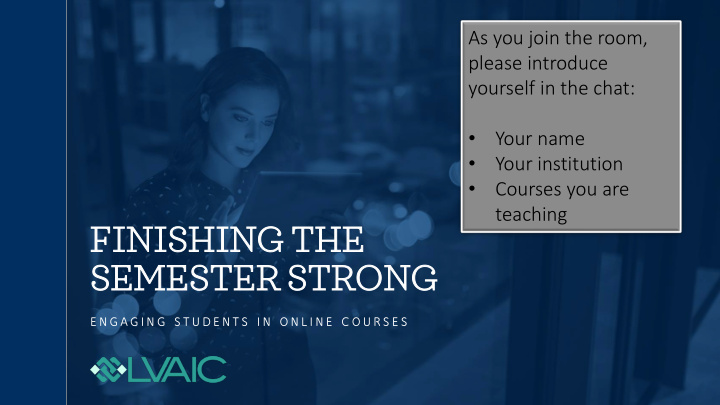



As you join the room, please introduce yourself in the chat: • Your name • Your institution • Courses you are teaching FI FINI NISHIN SHING G TH THE E SEME SE MESTER STER ST STRON ONG E N G A G I N G S T U D E N T S I N O N L I N E C O U R S E S
SESSION HOSTS Manuela Borzone, Ph.D. Eric J. Hagan, Ed.D. Assistant Director, CITLS Dean of Online Education Lafayette College DeSales University borzonem@lafayette.edu eric.hagan@desales.edu 610.282.1100, ext. 1689
AGENDA 1. Welcome 2. COVID College: the bad and the good 3. Finishing the semester strong 4. Breakout session #1: Ideas for “letting go” (10 min) 5. Preparing for spring 6. Breakout session #2: Ideas for engaging students (10 min) 7. Close
COVID COLLEGE BLUES • I can’t do {labs, performing arts, discussion, projects, group work, etc.} online! It’s not the same!!! • Technology-mediated communication not as rich as face-to-face • Can’t get to know masked students • Students just do the minimum online • I miss the students • I miss my colleagues • Lost sense of community • Everyone’s exhausted • Nobody signed up for this
BUT … • I only need a waist-up wardrobe • Parking is better • I’ve had to rethink the basics • I’ve learned a lot • We’re still here! How can my students and I thrive in this environment? This Photo by Unknown Author is licensed under CC BY-NC
FINISHING THE SEMESTER STRONG M A I N TA I N I N G F O C U S A N D AT T E N T I O N I N O N L I N E C O U R S E S
MIX IT UP 1. Devise non-screen time activities for live online sessions like "Muddy Points" 2. Jump-start participation though classic strategies like “Think -Pair- Share” 3. Use polling software to engage students 4. Try an asynchronous video-based discussion 5. Stage structured debates 6. Pet Day! This Photo by Unknown Author is licensed under CC BY
LETTING G GO: GO: ALLOWIN WING G ST STUD UDENT NTS S (SO SOME) ) CONT NTROL L • Why? • How? • Individual agency / choice • Whole-class agency / choice • Ideas • Choice of course topics • Choice of class activities • Let students teach something • Option for a creative vs. a standard assessment This Photo by Unknown Author is licensed under CC BY-SA-NC
On The Handmaid's Tale
BREAKOUT #1: LETTING GO 1. Moderator: group member whose FIRST name is first alphabetically 2. Moderator calls on each group member to introduce themselves: 1. Name 2. Institution 3. Role 3. Select a note-taker/reporter 4. 4. Ge Generate 2 2 id ideas as for givi iving stu tudents control th this is se semester th that ar are lik likely to o get th their attention. 5. Reporter shares with the larger group.
PREPARING FOR SPRING SEMESTER W H AT A R E Y O U G O I N G TO T R Y ?
1. How can I make my online class more relationship-based and less transactional? TO THINK 2. How can I make better use of synchronous vs. asynchronous class time (or, if a hybrid, in-class ABOUT … vs. online class time)? 3. What should I do more of? 4. What should I do less of?
If students can fully participate in an activity while THE LAUNDRY TEST folding laundry, it’s probably better as an asynchronous (recorded) activity. This Photo by Unknown Author is licensed under CC BY
BREAK EAKOUT #2 #2: : IDE DEAS AS FOR OR SPR PRIN ING G SEMES MESTER TER 1. Moderator: group member whose first name is LAST alphabetically 2. Moderator calls on each group member to introduce themselves: 1. Name 2. Institution 3. Role 3. Select a note-taker/reporter 4. 4. Ge Generate 2 2 id ideas as to tr try in in th the sp sprin ing to im improve stu tudent engagement. 5. Reporter shares with the larger group. This Photo by Unknown Author is licensed under CC BY
RESOURCES Abella, D. (2020, October 7). The new rules of engagement. The Chronicle of Higher Education. https://www.chronicle.com/article/the-new-rules-of-engagement Levy, D. (2020, August 7). The synchronous vs. asynchronous balancing act. Harvard Business Publishing Education . https://hbsp.harvard.edu/inspiring-minds/the-synchronous-vs-asynchronous-balancing-act Martin, F., & Bolliger, D. U. (2018). Engagement matters: Student perceptions on the importance of engagement strategies in the online learning environment. Online Learning , 22 (1), 205-222. doi:10.24059/olj,v22i1.1092 Martin, F., Polly, D. & Ritzhaupt, A. (2020). Bichronous online learning: Blending asynchronous and synchronous online learning. EDUCAUSE Review. https://er.educause.edu/articles/2020/9/bichronous-online- learning-blending-asynchronous-and-synchronous-online-learning McEldoon, K. & Schneider, E. (2020, July 24). 7 tips from research for effective hybrid teaching. Pearson Blog. https://www.pearsoned.com/7-tips-from-research-for-effective-hybrid-teaching/
Recommend
More recommend